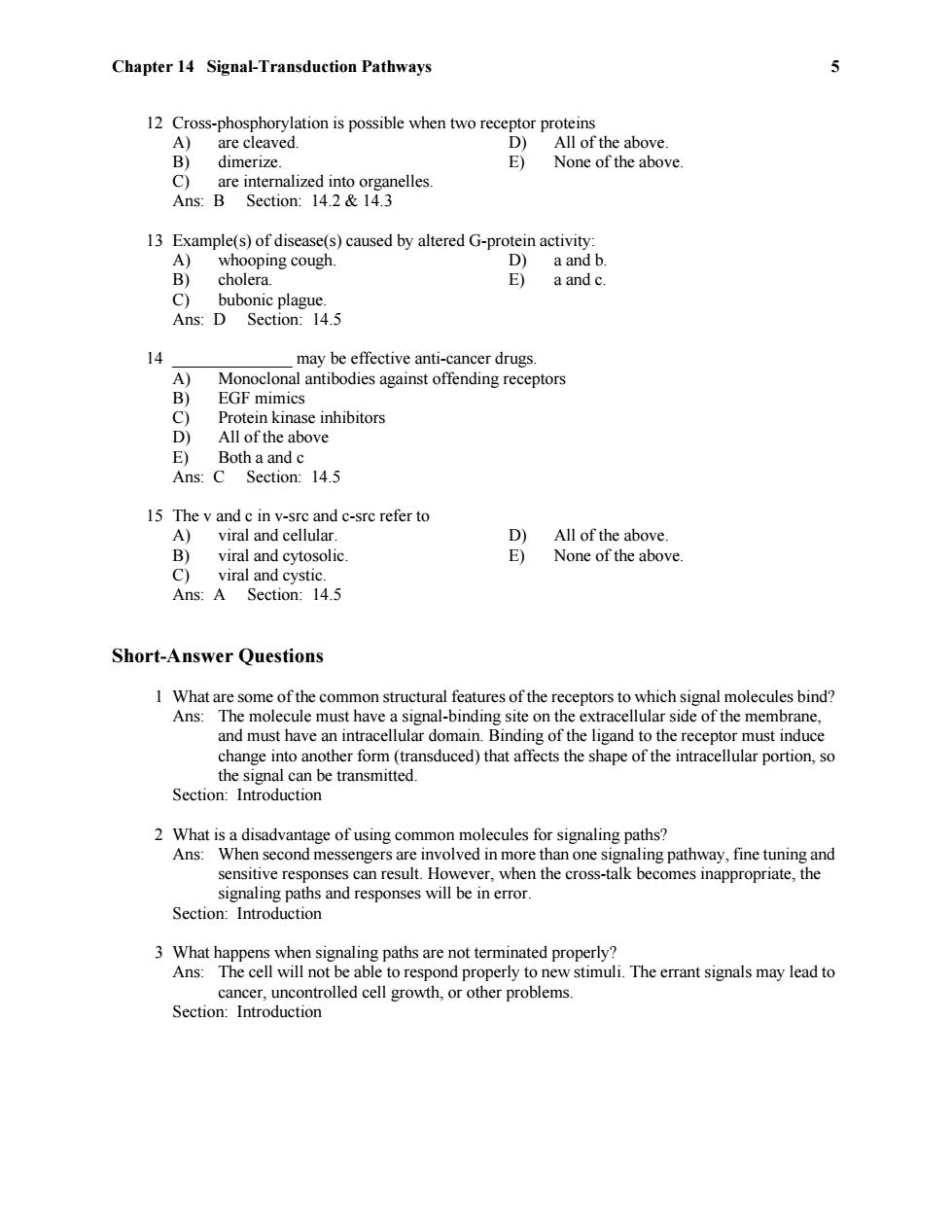正在加载图片...

Chapter 14 Signal-Transduction Pathways 12 Cross-phosphorylation is possible when two receptor proteins A) are cleaved. D) All of the above. B) dimerize. E) None of the above. c) are internalized into organelles. Ans:B Section:14.2 &14.3 13 Example(s)of disease(s)caused by altered G-protein activity: A) whooping cough. D) a and b. B) cholera. E) a and c. C) bubonic plague. Ans:D Section:14.5 14 may be effective anti-cancer drugs. A) Monoclonal antibodies against offending receptors B) EGF mimics C) Protein kinase inhibitors D) All of the above E) Both a and c Ans:C Section:14.5 15 The v and c in v-src and c-src refer to A) viral and cellular. D) All of the above. B) viral and cytosolic E) None of the above. C) viral and cystic. Ans:A Section:14.5 Short-Answer Questions 1 What are some of the common structural features of the receptors to which signal molecules bind? Ans:The molecule must have a signal-binding site on the extracellular side of the membrane, and must have an intracellular domain.Binding of the ligand to the receptor must induce change into another form(transduced)that affects the shape of the intracellular portion,so the signal can be transmitted. Section:Introduction 2 What is a disadvantage of using common molecules for signaling paths? Ans:When second messengers are involved in more than one signaling pathway,fine tuning and sensitive responses can result.However,when the cross-talk becomes inappropriate,the signaling paths and responses will be in error. Section:Introduction 3 What happens when signaling paths are not terminated properly? Ans:The cell will not be able to respond properly to new stimuli.The errant signals may lead to cancer,uncontrolled cell growth,or other problems. Section:IntroductionChapter 14 Signal-Transduction Pathways 5 12 Cross-phosphorylation is possible when two receptor proteins A) are cleaved. D) All of the above. B) dimerize. E) None of the above. C) are internalized into organelles. Ans: B Section: 14.2 & 14.3 13 Example(s) of disease(s) caused by altered G-protein activity: A) whooping cough. D) a and b. B) cholera. E) a and c. C) bubonic plague. Ans: D Section: 14.5 14 ______________ may be effective anti-cancer drugs. A) Monoclonal antibodies against offending receptors B) EGF mimics C) Protein kinase inhibitors D) All of the above E) Both a and c Ans: C Section: 14.5 15 The v and c in v-src and c-src refer to A) viral and cellular. D) All of the above. B) viral and cytosolic. E) None of the above. C) viral and cystic. Ans: A Section: 14.5 Short-Answer Questions 1 What are some of the common structural features of the receptors to which signal molecules bind? Ans: The molecule must have a signal-binding site on the extracellular side of the membrane, and must have an intracellular domain. Binding of the ligand to the receptor must induce change into another form (transduced) that affects the shape of the intracellular portion, so the signal can be transmitted. Section: Introduction 2 What is a disadvantage of using common molecules for signaling paths? Ans: When second messengers are involved in more than one signaling pathway, fine tuning and sensitive responses can result. However, when the cross-talk becomes inappropriate, the signaling paths and responses will be in error. Section: Introduction 3 What happens when signaling paths are not terminated properly? Ans: The cell will not be able to respond properly to new stimuli. The errant signals may lead to cancer, uncontrolled cell growth, or other problems. Section: Introduction